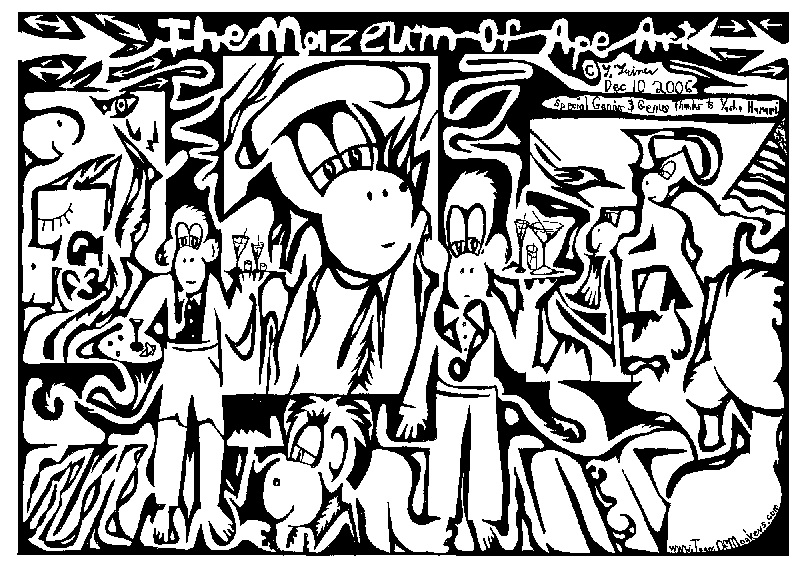Lost and Found in the Classroom
In 1990 I began to mediate cases for the Harvard Mediation Program; that same year I was hired to teach law and conflict resolution to undergraduates at Mount Ida College. It took me several years to realize how my experience as a mediator could enrich and improve my teaching methods in the classroom. It all came together when I began to use labyrinths and mazes as tools for teaching the mediation process.
The terms labyrinth and maze are often treated as synonyms, but there is one key difference between them: A labyrinth has only one way in and one way out; you cannot get lost or choose a wrong path. A maze has choices, various ways in and out, numerous dead ends and deceptive paths. In the Greek myth, Daedalus was commissioned to build a structure to house the deadly Minotaur (half man, half bull). The so-called “labyrinth” he constructed was actually an intricate maze, which prevented the Minotaur from finding its way out. This is why (later in the myth) Ariadne gave Theseus a long thread to help him find his way back out of the maze after slaying the Minotaur.
r in the Gothic cathedrals of the Middle Ages; the famous pavement labyrinth in the Cathedral at Chartres was designed to help people on their spiritual journeys. Pilgrims walked the winding path until they arrived at the heart of the labyrinth, a symbol of the quest for enlightenment.
I used to view teaching as a labyrinth, one way in, one way out: You came to class well prepared, gave interesting lectures, allocated time for group exercises and role-plays, assigned relevant readings and papers, and posed provocative questions for discussion. Students completed their assignments on time, came prepared to discuss the reading in class, studied diligently for exams, participated enthusiastically in group exercises, and mastered the major concepts of the course. What could be simpler?
You can stop laughing now. After a couple of semesters I realized that I couldn’t approach my courses the same way my professors had approached theirs. Students’ expectations often did not align with my own; they had different priorities, challenges and attitudes toward their work. Teaching was not, in fact, a labyrinth; it was a loopy and perplexing maze full of unexpected turns and dead ends, and I desperately needed a thread.
The thread emerged from my mediation training and practice, which, when I finally made the connection, helped me find a solution to the conflict between my students’ and my own expectations.
Mediation clients are not unlike our students: anxious, somewhat leery of the process, fearful of the unknown, hesitant to take risks. Disputing parties often expect the mediator to suggest solutions to their problems. But the first principle of mediation -- self-determination of the parties -- requires that the mediator not suggest but elicit solutions from the parties.
There are several reasons for this strategy, the most important of which is that if the solution does not come from the parties themselves, they feel less invested in their agreement and are less likely to uphold it. If a way out of their maze can be found, the parties must find it themselves, with the mediator’s guidance. In this respect, mediation is an exercise in critical and creative thinking, a form of teaching and learning.
At some point I realized that self-determination and ownership of outcomes was as important for my students as for my mediation clients. So I decided to apply this basic principle to one persistent problem I was encountering in the classroom.
I was frustrated in my Leadership Studies Seminar because students would not do the assigned reading before class. Instead of participating in a discussion of materials they had previously read, they came to class apparently expecting me to go through chapter and verse, highlighting everything they needed to know for the exam (and nothing else, thank you). Sound familiar?
I tried the usual strategies to encourage them to read the assigned pages before they came to class: in-class minute papers, group presentations, pop quizzes, study questions, penalties for lack of class participation. (I know that these tools can be helpful and even essential. They just didn’t solve this particular problem.) My students didn’t budge. I was giving myself a lot of extra grading and they still weren’t reading before they came to class. Yes, students who didn’t read the text got low grades on exams, but that didn’t improve class discussions or make me feel any better.
Clearly, as I often urged my mediation clients, I needed to approach the problem from a fresh perspective. I wanted my students to read the materials in advance so they were familiar with the issues raised in our class discussions, and not rely on me to do the reading and thinking for them. I didn’t want to spend valuable class time on pop quizzes or questions that received blank stares in return. I wanted the class to be fun and thoughtful and to get students to engage more actively. I had reached a dead end and needed to find a way out.
I settled on a plan that allowed for more choice and autonomy in how students prepared for class. In each class we would explore in depth only one or two major issues, based on short articles or passages (students chose them from a selection) we would read together at the beginning of class. However, students were responsible for all assigned readings on the syllabus, whether or not we discussed them in class. If they had questions or comments about the reading, they could bring them to class. If they had no questions, I would trust that they understood the material.
For exams, students could bring in any notes they had prepared themselves or in a study group. (No photocopies or handouts were allowed.) This policy obviated the need for memorization of the text and encouraged students to use their time to read all of the assigned materials, organize their thoughts, and approach the reading with a critical eye to determine how the information might appear on an exam.
No exam question could be answered straight out of the text; all questions called for application of leadership theories and concepts to scenarios drawn from our films. Students were required to support their arguments with concrete examples from the text and films, and in most cases, analyze and draw conclusions about the choices made by the leaders we were studying.
In the last class, armed with their notes, students gathered in small groups and drafted a list of five essay questions they thought would be appropriate for the final exam. Each group chose two questions to share with the class, and group recorders wrote them on the board. We then discussed possible answers and supporting evidence. The final exam had one required essay and a choice of four of six remaining essay questions.
The experiment succeeded on several levels. We all enjoyed the short communal readings and in-depth discussions; the material was fresh in our minds and everyone was on an equal footing in terms of preparation. For my students, the pressure was off to complete all of the required readings before each class, and I didn’t feel as though I had to lecture and review the reading in order to fill an information vacuum.
Most students (I wish I could say all) did the assigned reading at their own pace, brought well organized notes to exams, and in some cases formed study groups. Since students didn’t have to spend time memorizing the text or fake their answers on exams if they drew a blank, their essays were much more thoughtful and well-reasoned, in some cases a delight to read. And because they were given a choice of essays on the midterm and final, they could present their best work.
One unexpected bonus was that, since I no longer reviewed all of the textual material in each unit (students now owned that task), we had time to surf the Web to find supplemental information on the leaders we had viewed on film. My students took charge of that and enjoyed teaching me shortcuts through cyberspace.
Ink Blot Mazes
| Welcome to InkBlotMazes.com! You've probably seen our mazes in a newspaper, magazine, or games book and wanted more. Well, you've come to the right place, we have lots more Inkblot Mazes right here. |

Blivet Maze - 2009, By Yonatan Frimer
“They that mistake life's accessories for life itself are like them that go too fast in a maze: their very haste confuses them”
|
Maze of Monkey Illusion - 2009
Optical illusion maze caused by conflicting horizontal and vertical lines.

Maze of Monkey Illusion - 2008 - By Yonatan Frimer
| “Boris Podolsky: James! How's the rat business? James Moreland: Well, actually it's mostly students I'm experimenting on now. Kurt Godel: My God, the mazes must be enormous.” |
Maze of the Statue of Liberty - 2009

Maze of Liberty - 2009 - Yonatan Frimer
| “The man of character, sensitive to the meaning of what he is doing, will know how to discover the ethical paths in the maze of possible behavior.” |
Barak Obama Maze - 2009

Maze of Barak Obama - By Yonatan Frimer
| Real obstacles don't take you in circles. They can be overcome. Invented ones are like a maze. Barbara Sher |
Maze of 3D Impossible Object - 2009 - By Yonatan Frimer

Maze Zen Impossible - Yonatan Frimer 2009
| It is easier to penetrate your audience with one sharp, clean point or idea, thand with a maze of half-baked unremarkable, uninspiring ideas that will never motivate or be remembered. |
Maze Museum 2006

Mazeum, by Yonatan Frimer
| “Happiness, that grand mistress of the ceremonies in the dance of life, impels us through all its mazes and meanderings, but leads none of us by the same route.”
|
Maze of Barak Obama, profile view - 2009

Side Portrait Maze of Barak Obama, President
| When I was in New York it was like a maze, a rat maze, going from one little box to another little box and passing through passageways to get from one safe haven to another. Bruce Conner |
Maze - Kong 2006

Maze Kong - By Yonatan Frimer
| “Life is a maze in which we take the wrong turn before we have learnt to walk”
|
Maze King, of Rock N Roll, Elvis

Elvis Maze - By Yonatan Frimer
| "They that mistake life's accessories for life itself are like them that go too fast in a maze: their very haste confuses them." |
Matrix Maze - Keanu Reeves, Neo

Matrix Maze By Yonatan Frimer
| The maze ... was such a mind-altering and life-changing experience. ... My gosh, I mean for something that's pretend it changes your viewpoint on life, |
French Maid Maze - 2007

Maze Maid in France By Yonatan Frimer
Poem I found on the web about mazes...
Maze Poem
Maze I entered the maze not knowing what I’d find
A world so different within my own
The path was set
But never clear
As I walked along my eyes grew wide
I found so many things I thought I knew
But how different they now appeared
I continued looking for the end
Hopeful that I was getting near
Eventually I reached the end
But by then I realised it was only the beginning.
Magentia
ImagiPlay recalls bead mazes
By Staff -- Playthings,11/20/2008
 WASHINGTON—ImagiPlay is recalling approximately 500 bead maze toys because they pose a potential laceration hazard.
WASHINGTON—ImagiPlay is recalling approximately 500 bead maze toys because they pose a potential laceration hazard.
According to the U.S. Consumer Product Safety Commission, the trees on the toys can detach, exposing a metal screw and posing a laceration hazard to young children. No incidents or injuries have been reported involving the toys.
The recalled products are three styles of the Boulder, Colo.-based compay’s wooden Bead Mazes: Apple Tree, Cactus Tree and Palm Tree (pictured). They were sold at toy retailers nationwide from August 2008 through October 2008 for about $13.
The toys were made in the United States.
Consumers are asked to return the recalled toys to the store where purchased for a full refund. For more information, contact ImagiPlay at (800) 882-0217 or online at www.ImagiPLAY.com.
Post a comment Return to article View other article discussions
| Submitted by: | Brian Peterson (brian_d_peterson@iotatoys.com) 2/24/2009 9:33:48 PM PT |
A business coach once explained to me that one measure of integrity was one's ability to follow-through on their promises. And by exhibiting such integrity, trust will follow. Yet, can you imagine a business whose tagline commits themselves to integrity? That is what ImagiPLAY has done with their tagline "Toys with Integrity". The ImagiPLAY home page contains a product recall link at the top center of their page. The recall was self imposed by ImagiPLAY based on one incident which did not lead to an injury. They apparently do not turn a blind eye to product safety concerns, but rather follow through on their commitment to quality and safety of toys. Having visited the ImagiPLAY home page and paying attention to its product recall link, I could not help but to be inspired and intrigued by a company who's mantra focuses on integrity and whose actions support that mantra. If Barbera Aimes were to offer a business integrity workshop, there are many businesses who could truly benefit from her example.
York Maze owner Tom Pearcy seeks flexible opening hours
8:20am Thursday 26th February 2009
ONE of York’s newest tourist attractions is looking to shake up the times it is allowed to open – to secure its future in the face of North Yorkshire’s soggy summers.
The owners of the York Maze, near Elvington, have applied for permission to welcome visitors and stage events at different periods throughout the year, rather than being restricted to throwing open its fields from July to September.
Currently, the site – which moved to its present home after being forced to move from its original location next to the Grimston Bar park & ride to make way for the University of York’s Heslington East expansion – can only open for 13 weeks a year, with extra events requiring special dispensation.
And although Maze owner Tom Pearcy does not want to extend those opening limits, he is asking City of York Council to give the go-ahead to his suggestion that the attraction, which employs three full-time staff and around 30 seasonal workers and drew 50,000 visitors last year, should operate more flexibly.
He believes it would allow more room for manoeuvre following the huge debut fireworks display last November, which attracted 2,500 people and filled the void left by the lack of a civic Bonfire Night event in York. In a statement to the council, Mr Pearcy said: “York Maze is the country’s leading maze attraction – it is the largest and most visited maize maze in the UK and a vibrant and important part of the city’s tourist economy.
“The new site we are operating from has a much higher level of fixed costs than the old site. The two recent wet summers have given me concerns over the future viability of the business while depending on an eight-week opening window.
“Allowing the maze more flexibility would spread the fixed costs of the current operation and hopefully ensure the financial future of the business.
“Many of the other leading maize mazes across the world are having a great deal of success by opening for short periods during other seasons.
“Following the success of the York Maze Fireworks Spectacular, I would like the flexibility to open the site for such seasonal events which fall outside my current permission, as well as allowing the site to be used for private hire on occasions.”
Mr Pearcy said he was not asking to extend the 13-week opening limit, but would consider opening the Maze for eight weeks during summer and two or three weeks over Hallowe’en, leaving the remainder for “other possible uses, such as a Christmas event”.
He said: “I am not seeking to open the year round and it is not anticipated that daily visitor numbers would exceed those already experienced during the summer maze.”
The maze application is expected to go before the council’s planning committee in mid-April.
York Maze owner Tom Pearcy, who wants to stage events at different times during the year
 Comments (2)
Comments (2)
No comments:
Post a Comment